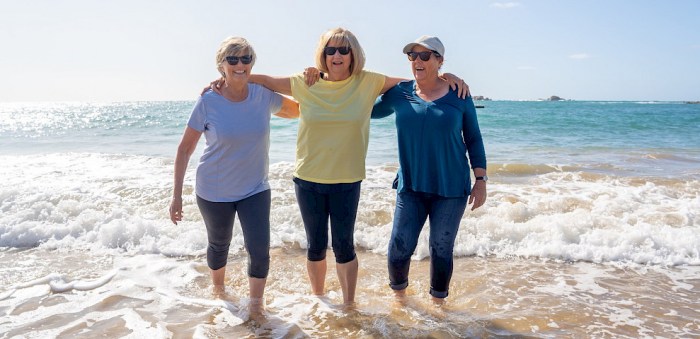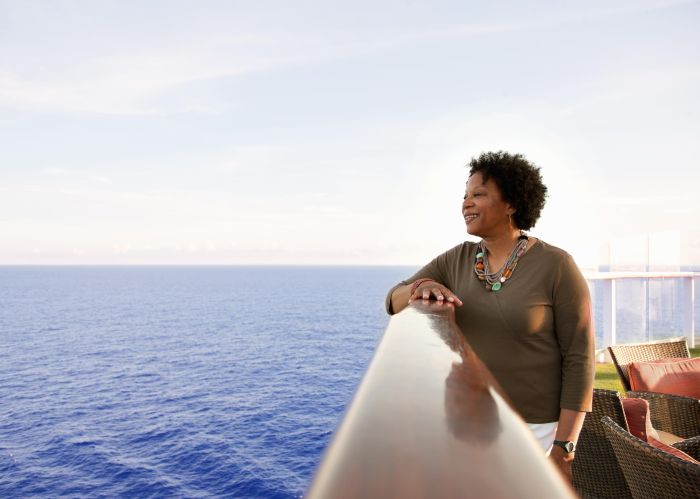Tours For Single Seniors are gaining popularity, offering a blend of adventure, companionship, and carefully curated experiences designed specifically for solo travelers in their later years. This burgeoning market caters to a demographic seeking enriching travel opportunities without the constraints of traditional group dynamics. From escorted tours providing comprehensive support to independent journeys emphasizing personal freedom, the options are diverse and cater to a range of budgets and preferences.
This guide explores the various facets of senior solo travel, addressing safety, cost, and the unique social dynamics involved.
We delve into the different tour types available, comparing escorted, independent, cruise, and adventure options, highlighting the pros and cons of each for single seniors. We also examine crucial aspects like accommodation, transportation, and the support services offered by reputable tour operators. Understanding the financial implications, choosing the right operator, and planning for a safe and enriching journey are key considerations we address.
Ultimately, this guide aims to empower single seniors to embark on memorable and fulfilling travel experiences.
Types of Tours

Choosing the right tour for single senior travelers requires careful consideration of individual preferences and needs. Factors such as desired level of independence, budget, and interests significantly influence the optimal tour type. This section explores various options, highlighting their advantages and disadvantages to facilitate informed decision-making.
Tour Type Comparison
The following table compares different tour types suitable for single seniors, weighing their pros and cons. Consider these factors when selecting a tour that best fits your travel style and budget.
| Tour Type | Pros | Cons | Suitability for Single Seniors |
|---|---|---|---|
| Escorted Tours | Organized itineraries, built-in social interaction, hassle-free travel, expert guidance. | Less flexibility, potential for rushed schedules, higher cost, may cater to a broader age range. | Excellent for those seeking convenience and companionship, but may feel restrictive for independent travelers. |
| Independent Tours | Maximum flexibility, personalized itineraries, potential for cost savings (if booking independently). | Requires more planning and research, potential for loneliness, increased responsibility for logistics and safety. | Suitable for experienced travelers who are comfortable with self-reliance and enjoy exploring at their own pace. |
| Cruise Tours | All-inclusive packages, varied onboard activities, opportunity for relaxation and socialization, multiple destinations. | Potential for seasickness, limited shore excursions, can be expensive, less flexibility in itinerary. | Appealing for those seeking a relaxing and convenient way to visit multiple locations, but may not be suitable for those prone to motion sickness. |
| Adventure Tours | Unique experiences, opportunities for physical activity and exploration, potential for personal growth. | Demanding physical fitness, potential safety risks, may not be suitable for all health conditions, higher cost. | Best suited for active seniors with good health and a spirit for adventure; careful assessment of fitness levels is crucial. |
Unique Tour Themes for Single Seniors
Several tour themes cater specifically to the interests and preferences of single senior travelers, fostering social interaction and enriching travel experiences.
Historical Sites Tours
These tours focus on exploring significant historical landmarks, museums, and cultural sites. They often include guided tours by experts, providing in-depth knowledge and historical context. For example, a tour focusing on Roman history could encompass visits to Rome, Pompeii, and other significant archaeological sites in Italy, offering a blend of historical immersion and cultural exploration. The benefits include intellectual stimulation, opportunities for learning, and connecting with shared history.
Drawbacks might include a fast pace for some, and potential physical limitations in accessing certain sites.
Culinary Tours
These tours emphasize the exploration of local cuisines and culinary traditions. They might include cooking classes, visits to local markets, wine tastings, and dining experiences at renowned restaurants. A tour focused on Tuscan cuisine, for instance, could involve hands-on pasta-making classes, visits to olive oil farms, and wine tasting sessions in the Chianti region. The advantages include sensory experiences, opportunities to learn new skills, and the chance to savor authentic local flavors.
Drawbacks could include dietary restrictions or potential weight gain if not managed consciously.
Nature Excursions
These tours concentrate on exploring natural landscapes and engaging in outdoor activities. Options could range from gentle nature walks to more challenging hikes, depending on the fitness level of participants. A tour focused on exploring the Canadian Rockies, for instance, could include scenic drives, hikes through alpine meadows, and wildlife viewing opportunities. Benefits include relaxation, stress reduction, and opportunities for physical activity within a supportive environment.
However, drawbacks might include physical limitations, weather dependence, and potential risks associated with outdoor activities.
Accommodation and Transportation
Tours designed for single seniors prioritize comfort and convenience, recognizing the unique needs of this demographic. Careful consideration is given to both accommodation and transportation options to ensure a seamless and enjoyable travel experience. Factors such as accessibility, ease of navigation, and safety are paramount in the selection process.Accommodation options typically cater to the preference for independent travel, offering a range of choices to suit individual needs and budgets.
Transportation arrangements are meticulously planned to minimize stress and maximize enjoyment, leveraging various modes of transport depending on the itinerary and destination.
Accommodation Options for Single Seniors, Tours For Single Seniors
Single occupancy rooms are the most common accommodation option, eliminating the need for shared spaces and ensuring privacy. This is a significant advantage for solo travelers who value their personal space and independent routines. Some tour operators also offer private apartments or suites for those seeking more expansive accommodations. These options often include added amenities such as kitchenettes or living areas, providing a greater sense of independence and comfort.
In some cases, shared rooms may be offered as a more budget-friendly alternative, although this is less common given the emphasis on individual comfort in senior-focused tours.
Transportation Methods and Suitability for Senior Travelers
The choice of transportation significantly impacts the overall tour experience for senior travelers. A variety of methods are employed, each with its own advantages and disadvantages. The selection process considers factors such as accessibility, comfort, and travel time.
| Transportation Method | Advantages | Disadvantages | Suitability for Seniors |
|---|---|---|---|
| Motorcoach/Bus | Relatively inexpensive, convenient for group travel, often includes amenities like restrooms and climate control. | Can be less comfortable for long journeys, limited flexibility in itinerary. | Generally suitable, especially for shorter trips and with comfortable seating and frequent stops. |
| Train | More comfortable than buses for long distances, scenic views, often offers amenities like dining cars. | Can be more expensive than buses, less frequent service in some areas, may require navigating stations. | Suitable for many seniors, particularly those who prefer a more relaxed travel experience. |
| Private Car/Van | Greater flexibility in itinerary, personalized service, convenient for door-to-door transport. | Significantly more expensive than other options, limited seating capacity. | Highly suitable for seniors with mobility challenges or those who prefer personalized service. |
Senior-Friendly Hotel Experience
Imagine staying at the Grand Hyatt Kauai Resort & Spa. This hotel, while not exclusively for seniors, exemplifies many senior-friendly features. Accessibility is a key focus, with ramps, elevators, and wide doorways throughout the property. Rooms are designed with ample space for wheelchairs and walkers, and grab bars are provided in bathrooms. Amenities cater to a wide range of needs, including accessible pools, spa services, and on-site dining options with varied menus.
The staff is trained to assist guests with mobility challenges and are readily available to provide assistance as needed. The hotel’s calm and peaceful atmosphere contributes to a relaxing and enjoyable stay, reducing stress and promoting well-being. The availability of various levels of assistance, from simple help with luggage to more intensive care, ensures that guests can customize their level of support based on their individual requirements.
Social Aspects and Companionship
Travel, particularly for single seniors, often presents an opportunity to combat loneliness and foster new connections. Tour operators specializing in this demographic actively cultivate a social environment, recognizing the significant role companionship plays in overall well-being and enjoyment. Structured activities and shared experiences are key components of this strategy.Tour operators facilitate social interaction through a variety of methods, creating opportunities for bonding and friendship development.
This is achieved not only through the carefully planned itineraries but also through the deliberate creation of an inclusive and welcoming atmosphere. The shared experience of travel itself provides a natural common ground, encouraging conversation and interaction.
Structured Social Activities
Many tours for single seniors incorporate activities specifically designed to encourage social interaction. These range from informal gatherings, such as welcome receptions and cocktail hours, to more structured events like cooking classes, wine tasting sessions, or guided walking tours in smaller groups. The shared participation in these activities creates a sense of camaraderie and provides ample opportunities for conversation and connection.
For example, a cooking class allows participants to collaborate on a meal, fostering teamwork and conversation, while a guided walking tour provides a shared experience and talking points for participants. These events are not merely add-ons but integral parts of the tour experience, deliberately scheduled to maximize interaction.
Combatting Loneliness and Isolation
The structured nature of these tours, coupled with the shared experiences, actively works to combat loneliness and isolation often experienced by single seniors. The consistent social interaction, facilitated by both the planned activities and the inherent social dynamics of group travel, helps build a sense of community and belonging. This is particularly important for individuals who may have limited social interaction in their daily lives.
The feeling of being part of a group, engaged in shared activities and conversations, can significantly improve mental well-being and reduce feelings of isolation. The shared experiences provide a rich source of conversation and connection, fostering a sense of belonging and reducing the feeling of being alone. Many testimonials from past participants highlight the lasting friendships forged during these tours.
Budgeting and Cost Considerations
Planning a tour for single seniors requires careful budgeting to ensure a comfortable and enjoyable experience without exceeding financial limits. Understanding the various cost components and comparing different tour options are crucial for maximizing value and minimizing unexpected expenses. This section will Artikel potential costs, compare tour types, and provide a sample budget.
Potential Tour Costs
Several factors significantly influence the overall cost of a senior tour. A comprehensive budget should account for all anticipated expenses.
- Tour Price: This is the base cost, varying widely depending on the destination, duration, itinerary, and level of luxury. Prices can range from a few thousand dollars for a simple domestic tour to tens of thousands for a luxurious international trip.
- Flights: Airfare can represent a substantial portion of the total cost, especially for international travel. Booking flights well in advance or during off-peak seasons can often yield significant savings.
- Meals: Tour packages may include some or all meals. If meals are not included, budgeting for daily meals is essential. Consider the cost of dining out versus preparing some meals independently, if accommodation allows.
- Activities and Excursions: Many tours offer optional excursions or activities at an additional cost. These can range from guided tours of historical sites to participation in local cultural events. Factor these potential expenses into the overall budget.
- Accommodation: The type of accommodation significantly impacts the cost. Options range from budget-friendly hotels to luxurious resorts. Single occupancy rooms often incur a surcharge compared to double occupancy.
- Travel Insurance: Comprehensive travel insurance is highly recommended, covering medical emergencies, trip cancellations, and lost luggage. The cost varies based on the level of coverage and the destination.
- Personal Spending Money: Allocate a realistic amount for personal expenses, including souvenirs, tips, and incidental purchases.
Cost-Effectiveness of Different Tour Types
The cost-effectiveness of a tour depends on several factors, including the type of tour and travel style. Group tours often offer better value for money due to economies of scale, while independent travel offers more flexibility but can be more expensive. Cruises, for example, can bundle accommodation, meals, and some activities into a single price, potentially offering better value than land-based tours with separate costs for each element.
Conversely, independent travel, while potentially more expensive overall, allows for greater customization and control over spending.
Sample 7-Day Tour Budget
This sample budget assumes a moderately priced 7-day tour to a popular domestic destination. Individual costs will vary based on specific choices.
| Expense Category | Estimated Cost |
|---|---|
| Tour Package (including accommodation) | $2,500 |
| Flights (round trip) | $500 |
| Meals (partially included in tour) | $350 |
| Activities and Excursions | $200 |
| Travel Insurance | $100 |
| Personal Spending Money | $350 |
| Total Estimated Cost | $4,000 |
Note: This is a sample budget and actual costs may vary significantly. Consider using online budgeting tools to create a more personalized plan.
Choosing the Right Tour Operator: Tours For Single Seniors

Selecting the right tour operator is paramount for a successful and enjoyable single senior travel experience. A reputable operator will not only handle the logistics efficiently but also prioritize the specific needs and concerns of older travelers, ensuring a safe, comfortable, and engaging journey. Failing to do thorough research can lead to disappointment, unforeseen costs, and compromised safety.Choosing a reputable tour operator requires careful consideration of several key factors.
These factors extend beyond simply comparing prices and destinations, delving into the operator’s experience, commitment to senior traveler needs, and overall reputation. A thorough vetting process is crucial to ensuring a positive travel experience.
Key Factors in Operator Selection
Several critical aspects should guide the selection of a tour operator specializing in single senior travel. These include the operator’s experience with this specific demographic, their safety protocols, the level of support offered, the clarity of their terms and conditions, and customer reviews. Operators with a proven track record of successfully managing tours for single seniors, coupled with positive feedback from past clients, significantly reduce the risk of unexpected problems.
Questions to Ask Potential Tour Operators
Before committing to a tour, single seniors should proactively gather essential information. This involves inquiring about the operator’s experience catering to solo travelers, their policies regarding single supplements, the level of support provided during the trip, the details of the itinerary, and the operator’s cancellation and refund policies. Understanding these aspects allows for informed decision-making and reduces the likelihood of encountering unexpected issues.
For example, a senior traveler might ask about the availability of accessible transportation and accommodation options, emergency contact procedures, and the nature of the group size.
Comparison of Tour Operators
Let’s consider two hypothetical tour operators, “Silver Linings Tours” and “Golden Years Getaways,” both catering to single senior travelers. Silver Linings Tours emphasizes small group sizes (maximum 12 participants) and focuses on culturally immersive experiences, offering personalized attention and opportunities for interaction. Their itineraries often include optional activities to cater to individual interests. Golden Years Getaways, on the other hand, may offer larger group tours with a broader range of destinations and a more structured itinerary, potentially focusing on ease of travel and minimizing individual planning.
Both operators offer different strengths and cater to varying preferences; the choice depends on the individual traveler’s priorities. For instance, Silver Linings might be ideal for those seeking a more intimate travel experience, while Golden Years Getaways might suit those prioritizing affordability and ease of travel.
Embarking on a tour designed for single seniors offers a unique opportunity to explore the world, forge new friendships, and create lasting memories. By carefully considering the various tour types, prioritizing safety, and selecting a reputable operator, solo travelers can enjoy a seamless and enriching experience. The benefits extend beyond the sights and sounds of the destination; they encompass personal growth, social connection, and a renewed sense of independence and adventure.
Ultimately, the journey is as much about the destination as it is about the enriching experiences and newfound friendships along the way.

